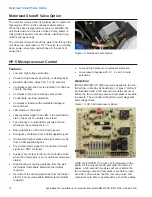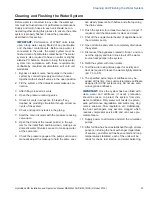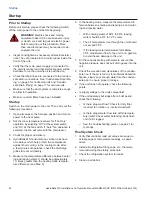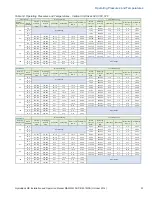
HydroBank MS Installation and Operation Manual MAMM-WSHP-IOM-1MSA (October 2014)
23
Cleaning and Flushing the Water System
Cleaning and Flushing the Water System
Before water is connected to any units, the water sys-
tem must be flushed clean of particulate contaminants.
Supply and return hoses to each unit should be con-
nected together during this process to ensure the entire
system is properly flushed. Follow the procedures
described in this section.
IMPORTANT:
Performance of WSHP units relies
upon a loop water supply filtered of any particulate
and chemical contaminants. Before loop water is
connected to the units, the water system must be
flushed clean of particulate contaminants. The water
system is also required to have a neutral or slightly
alkaline PH balance. Failure to bring the loop water
system into compliance with these requirements,
verifiable by recorded documentation, will void unit
warranties.
1. Bypass all water source heat pumps in the water
system by connecting supply and return hoses
together with all shutoff valves in the open position..
2. Fill the system at the domestic water makeup con-
nection.
3. After filling, close all air vents.
4. Open the pressure reducing valve.
5. Check air vents in sequence to bleed off any
trapped air, providing circulation through all compo-
nents of the system.
6. Check and repair any leaks in the piping.
7. Start the main circulator with the pressure reducing
valve open.
8. Open the drains at the lowest point(s) in the sys-
tem for the initial flush and blow down, making sure
domestic water fill valves are set to make up water
at the same rate.
9. Check the pressure gauge at the pump suction and
manually adjust the makeup to hold the same posi-
tive steady pressure both before and after opening
the drain valves.
10. Flush the system for at least two hours, or longer if
required, until the drain water is clear and clean.
11. Shut off the supplemental heater (if applicable) and
the circulator pump.
12. Open all drains and vents to completely drain down
the system.
13. Disconnect the bypasses created in Step 1 and con-
nect the supply and return lines to all of the water
source heat pumps in the system.
14. Refill the system with clean water.
15. Test the water using litmus paper for acidity and
treat as required to leave the water slightly alkaline
(pH 7.5 to 8.5).
16. The specified percentage of antifreeze may be
added at this time. Use commercial grade antifreeze
designed for HVAC systems only. Do not use auto-
motive grade antifreeze.
IMPORTANT:
Once the system has been filled with
clean water and antifreeze (if used), precaution
should be taken to protect the system from dirty
water conditions. Dirty water will result in system-
wide performance degradation and solids may clog
valves, strainers, flow regulators, etc. Additionally,
the heat exchangers may become clogged which
reduces compressor service life and can cause pre-
mature failure.
17. Supply power to all motors and start the circulation
pumps.
18. After full flow has been established through all com-
ponents, including the heat exchanger (regardless
of season), and after air has been vented and loop
temperatures stabilized, each of the units will be
ready for check, test, startup, and water balancing.
















































